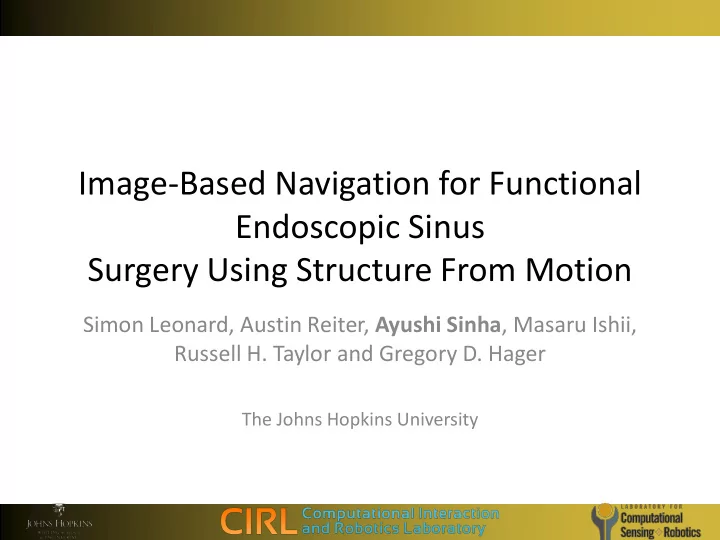

Image-Based Navigation for Functional Endoscopic Sinus Surgery Using Structure From Motion Simon Leonard, Austin Reiter, Ayushi Sinha , Masaru Ishii, Russell H. Taylor and Gregory D. Hager The Johns Hopkins University
Introduction • Functional Endoscopic Sinus Surgery (FESS) is a challenging Partially procedure for exposed otolaryngologists artery • Over 250,000 FESS are performed annually in the USA • Use to treat common conditions such as chronic sinusitis • Surgeons remove several layers of cartilage and tissues Same that are within millimeters of exposed critical anatomical structures artery (nerves, arteries, ducts)
Motivation • Complications of FESS – Major: 0.31-0.47% – Minor: 1.37-5.6% • Safety and efficiency are improved by using navigation systems • State of the art navigation systems have reported accuracy greater than 1 mm which Overlay of middle turbinate (CT) on is large considering the video images scale of the sinus cavities
Previous Work • Previous Video-CT registration used pairs Tracker-based of cadaver images – Using needles as fiducials – Using image pairs Image-based – Reprojection distance error of 1.28 mm (1.82 mm for tracker) Reprojection error between tracker based and image-based Methods Mirota IEEE TMI 2013
Objectives 1. Test video-CT registration with in-vivo data – Test registration for erectile tissues – Less “feature rich” images 2. Use a greater set of video images for registration 3. Manageable computation time Sample video sequence (1 second)
Method 1. Use a set of images to compute structure from motion (SfM) 2. Scale structure and motion to CT using the magnitude of tracking trajectory – Magnetic tracker is used to estimate the scale of the motion 3. Register the 3D structure to CT using trimmed-ICP (TriICP) with scale – Initial guess must be provided
SfM Hierarchical Multi-Affine Matching • SfM is computed from a set of matched image-features (SIFT or SURF) • Endoscope images and motion are challenging for conventional matching algorithms • HMA matches increases quantity and quality of matches – SURF are extracted from a pool of GPU – Initial SURF matches using brute force algorithm – HMA matches computed using a pool of CPUs
SfM Sparse Bundle Adjustment • SfM with SBA is computed from HMA matches • The structure and motion are scaled according to the magnitude of the motion as measured from the magnetic tracker • One second of video (~30 frames) yields between 800 and 1000 points
Trimmed Iterative Closest Point with Scale • The scaled structured is registered to the mesh of the CT scan • Use 70% of inliers to register structure points to CT • Allow to scale structure to compensate for tracker inaccuracy • Initial guess must be provided
Erectile/Non-Erectile tissues • Account for erectile/non-erectile tissues – Congestion cause some tissues to swell – Discrepancy if CT was obtained weeks before video Congested view (CT) Decongested view (video) of the middle turbinate of the middle turbinate
Results • Video data was captured from JHOC – ~90 seconds per patient – Divided in one second video sequence (~30 frames) • Five sequences with erectile tissues and five sequence with non-erectile tissues – Non-erectile tissues TriICP residual: 0.91 mm (0.2 mm) – Erectile tissues TriICP residual: 1.21 mm (0.3 mm) • Average computation time – 10.2 seconds (1.3) for 30 frames
Results • No ground truth available • Measure reprojection error using overlaying of anatomical structure (middle turbinate) (𝐽 𝐵 ⊕ 𝐽 𝐶 ) 𝐽 𝐶 • 86% mean reprojection accuracy (std 3%) – Middle turbinate is surrounded by erectile tissues
Conclusion and Future Work • FESS is commonly used for treatments of chronic sinus diseases • Current navigation systems have limited accuracy • Our research introduces a video-CT registration with sub-millimeter accuracy for non-erectile tissues with in-vivo data • Proposed video-CT registration enables overlay of CT structures (visible or occluded) on video data • Computation time is comparable to state of the art navigation systems (inserting and removing markers) • Future work includes analysis of robustness to initial registration guess
Thank you! Questions? Acknowledgement: This work is funded by NIH R01-EB015530: Enhanced Navigation for Endoscopic Sinus Surgery through Video Analysis.
Recommend
More recommend